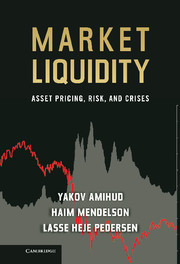Book contents
- Frontmatter
- Contents
- Acknowledgments
- Introduction and Overview of the Book
- Part I The Effect of Liquidity Costs on Securities Prices and Returns
- Part II Liquidity Risk
- Part III Liquidity Crises
- Introduction and Overview
- Chapter 6 Market Liquidity and Funding Liquidity
- Market Liquidity and Funding Liquidity*
- Chapter 7 Liquidity and the 1987 Stock Market Crash
- Chapter 8 Slow Moving Capital
- References for Introductions and Summaries
- Index
Chapter 7 - Liquidity and the 1987 Stock Market Crash
Summary and Implications
Published online by Cambridge University Press: 05 December 2012
- Frontmatter
- Contents
- Acknowledgments
- Introduction and Overview of the Book
- Part I The Effect of Liquidity Costs on Securities Prices and Returns
- Part II Liquidity Risk
- Part III Liquidity Crises
- Introduction and Overview
- Chapter 6 Market Liquidity and Funding Liquidity
- Market Liquidity and Funding Liquidity*
- Chapter 7 Liquidity and the 1987 Stock Market Crash
- Chapter 8 Slow Moving Capital
- References for Introductions and Summaries
- Index
Summary
This article establishes the relation between stock market crashes and liquidity shocks, presenting evidence from the October 19, 1987 stock market crash. It argues that the crash was due in part to a realization that financial markets were not as liquid as had been previously assumed, and that liquidity can suddenly dry up. The paper proposes that the price decline reflected in part a reevaluation of stocks in light of the realization that their liquidity was lower. In fact, stocks whose liquidity deteriorated more also suffered greater price decline.
Leading into the crash, there were a number of days of negative news and sharp price declines, which triggered sell-off by program traders that employed strategies of portfolio insurance and dynamic hedging, which exacerbated the declines. The financial markets then became less liquid in the United States and globally. The average bid–ask spread doubled and the quoted market depth – measured by the number of shares that dealers and traders are willing to trade at the quoted bid and ask prices – fell substantially. Trading was also hampered by technical difficulties related to handling the transaction volumes, stocks opened late, market makers who normally provided liquidity faced severe funding problems, and there were even rumors that the NYSE would shut down. The lack of liquidity and liquidity risk became scarily apparent and made investors incorporate greater liquidity discount into stock prices.
- Type
- Chapter
- Information
- Market LiquidityAsset Pricing, Risk, and Crises, pp. 245 - 257Publisher: Cambridge University PressPrint publication year: 2012
- 1
- Cited by



